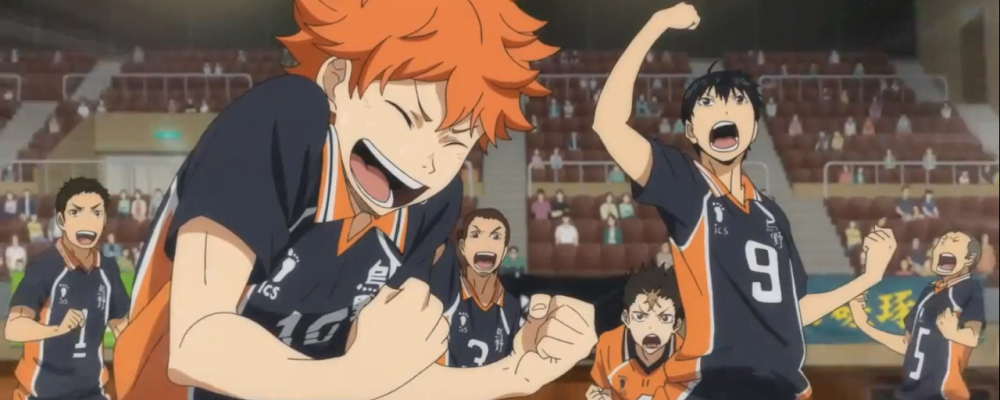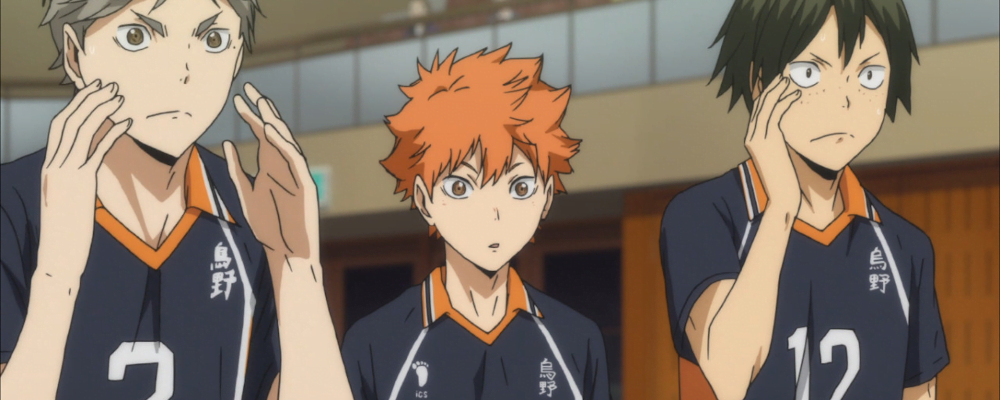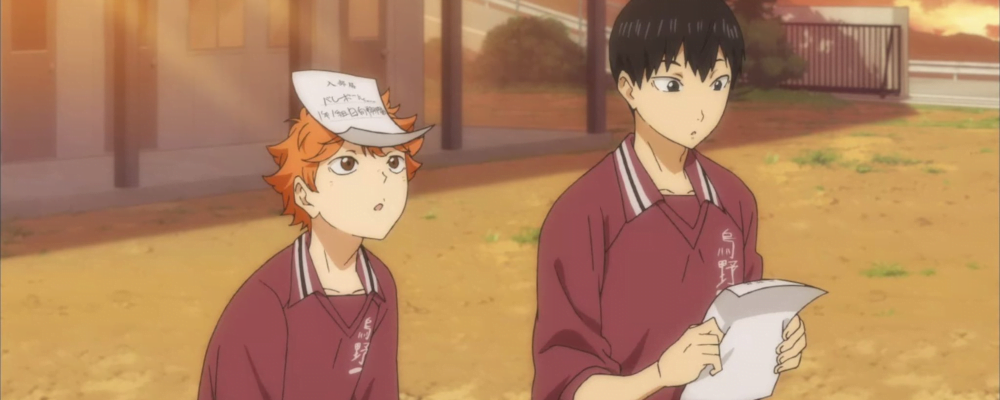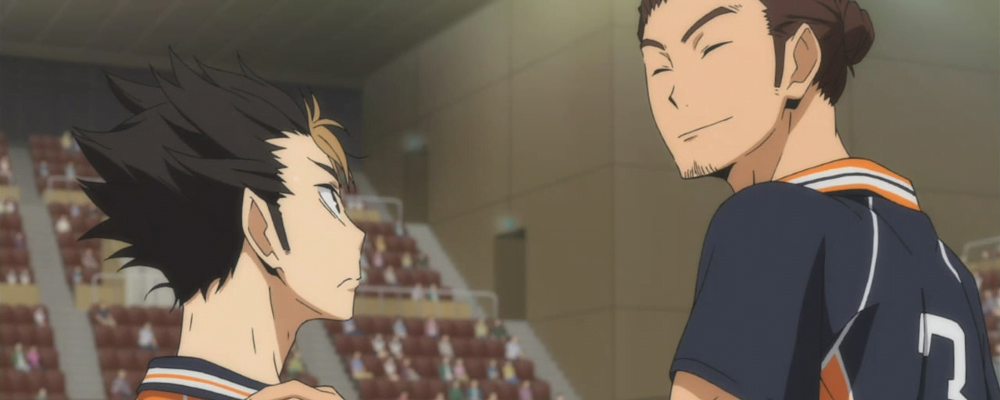What? Wait a minute! This isn’t smooch material! This isn’t smooch material at all! What gives, Talen?
Come with me on this journey.

First let’s give you your vital statistics. Haikyuu!! is a manga that started in 2012, and concluded mid-last year. I haven’t read the manga, but I have watched the first three seasons of the anime, which I am told is a very faithful adaptation of the manga. The manga author is Haruichi Furudate, it was published in Weekly Shonen Jump, it was made by Production IG and has a few spinoffs like a gag-a-day manga and OVAs focusing on side stories the main story only implies, and, uh.
It’s about volleyball.
Not supernatural volleyball, not metaphorised volleyball, not volleyball but everyone is a mecha pilot, not volleyball but they’re magical girls, this is genuinely just a series about boys high school volleyball, and it is so down to earth and grounded in its approach to being high school volleyball that it literally wrings comedy out of just the straightforward, clear, simple reality of it being a story about high school boys playing volleyball.
This is a well-worn genre, of your typical anime characters playing a sport in a heightened reality of anime and manga storytelling. It’s something so much a part of our landscape, Fox and I even just tend to call it a ‘sportsboy’ anime – it’s an anime about hot boys doing sport. These are, renownedly, not uh, good? Like, they’re a popular genre, but let’s just say that sometimes their relationship to sports is a little tenuous. Many of these shows rely heavily on hot characters having sexually metaphorical long term competitive conflicts and I mean that was good enough for Bleach, so it’s not like it’s a bad thing.
Haikyuu!! is basically my first sportsboy anime that I unabashedly think of as great, though. I liked it a lot, I really enjoyed it, and I may have watched all of it in four days.

It opens with an absolutely killer hook for your standard version of this narrative, mind you. We meet first Hinata Jumpyboy, the most energetic and enthusiastic of volleyball sportsboys that there is. He has put together his rag tag team of misfits who have never been able to play, not for real, and they’re here to put their hearts into the game and try their best. But oh no, they draw against The King of the Court in their first tournament, and are then crushed and crushed and crushed.
Infuriated, Hinata The Frog meets the King of the Court, outside the game, and pledges, here and now, in the last days of his junior high, that he’s going to beat this asshole.
It is a perfect, contained, excellently constructed little origin story arc for a character to set up a nemesis for the ongoing narrative that follows. It is a story about feeling inadequate and trying your best and having a dream and even driving yourself with all the practice you can muster, but finding that all your work just brings you to the stage where you can meet the people who have advantages you didn’t. The entire arc of the series is set here, and the first episode shows you, with this really excellent animation style, that the series can take volleyball as a subject seriously to build all those episodes out. Hinata has a new school, a rival, and a drive, and he’s going to kick things off in his brand! new! volleyball! club!
And then at the end of the first episode it throws that entire plot in the trash, by having him open the door and find his rival there.
Right there.

Alright, now, like I said, this is a journey, but let’s real quickly bring up a list I mentioned back in the day referencing the Deep Space 9 episode Take Me Out To The Holosuite. There’s this list I use to examine how a media piece about a game uses a game, and whether or not that game as depicted is a meaningful part of the story. This list was in reference to 14th century plays, so basically, if you can’t manage this checklist for a game in your media, you are behind the curve.
Here then is the list, and how Haikyuu!! handles it.
- Relevant rules of the game are communicated meaningfully for an audience that does not know them. This is constant. I know more about playing Volleyball after watching this series than I ever did and I used to play Volleyball.
- Irrelevant rules of the game are followed anyway, meaning that the game is being meaningfully played. This is regular. Positioning rules are not explained for the first season, but they still do rotations and still make sets properly.
- If you come into the episode at mid points, the game state is coherent and meaningful. The show regularly shows you matches in progress by showing you the score regularly and one entire season is dedicated to a match, meaning you are sometimes coming into an episode mid-game.
- Ordinary game actions are executed by players in ways that express who those characters are. Absolutely constant here – every player’s play style is used to inform their personality and even to show growth.
- The game is not distorted beyond capacity for the narrative – there’s no moment when a player flips a perfect poker hand three rounds in a row, characters actually play the game. You get long, slow shots of characters floating and shooting, but the game is still moving at natural speed. Nobody hits the ground before the ball they dropped, time is fixed and even if you get long moments of inner monologuing, the rules of volleyball aren’t being changed. This is especially great because in this anime, characters are always playing seriously – there’s no manipulating someone to lose, it’s really just playing volleyball.
- The game is actually winnable or losable – there is no secondary mechanic meaning that all the play prior is meaningless like the Golden Snitch. It’s volleyball. The game follows the rules of volleyball. Nobody ever wins or loses to things like ‘the umpire died.’
- The game’s purpose as an equal playing field is used to compare characters to one another. Constantly. Characters compare across their positions and playstyles all the time.
- The game’s purpose as a cultural element is used to show the importance of the play and not just some arbitary rules point. This is for your sort of stories where say, a character gets suckered into a duel, and then that duel means they have to, I dunno, accidentally touch a sacred stone, like you see in sci-fi stories.
Haikyuu!! is so good at these elements that I don’t really feel I need to show you examples, because the show itself is the examples. If you want to look at a way a game can be used in media to tell stories, Haikyuu!! is great at it.

Why why why then are we looking at this anime I really liked in Smooch Month?
Not because of the smoochiness it has but the smoochiness it can have.
Traditionally speaking, I am pretty down on the idea of treating fan media as if it affects the main media. During pride month, there’s a lot of work I don’t consider valuable to talk about because what queerness that media has is entirely the work of fans. I’m not going to give anime with a lot of shipping potential a pass on its romance options when the anime itself avoids showing any queer relationships. Johnlock does not get to fly in my pride month. Voltron, incidentally, does, because it actually has queer relationships in it.
Haikyuu!! is not getting to show up in Smooch Month because there is a lot of fanart of the boys kissing, though, yes, that’s out there, and you should definitely find the stuff you like of the form. But what I think Haikyuu!! deserves special mention for, in this, the smoochiest of months, is how well it presents boys. Yes, I am about to talk about some anime characters as if they would be good templates to use for stories about characters smooching. You can, no doubt, bust out your ‘cancelled’ and ‘child coded smooches’ nonsense if you want to.
The thing about smooch media, though, is it is consistently bad at depicting men. Oh, yes, smooch media treats women terribly as well, patriarchy beats downwards, but the men presented by this existing media space are consistently dreadful. Leading men – even in men targeted media! – are whiny and obnoxious or stupid or emotionally clueless or selfish and foolish and reckless and the story gets choked around the narrative inevitability that oh yes, as bad as this person is, he is The love interest, and therefore, you’re going to end up in his swamp in the end. God, that wasn’t meant to be a Shrek reference but yes, him too.
I want to talk about Haikyuu!! for smooch month, because Haikyuu!! is an anime which is full to the bursting with good boys. The characters have meaningful emotional exchanges, they understand each other’s feelings, they have a drive to work together that is neither obligatory nor compulsory, and they are willing to do things for one another, even as they correct each other, squabble, and learn from one another. If you want to see a large variety of boys who are nice and good in a lot of different ways, many of which do not immediately and obviously present as ‘nice and good,’ then you can do a lot worse by looking at Haikyuu!! and its cast of characters and their many relationships. It’s like a fractal spiderweb of different ways to interpret characters’ relationships with one another, and if you use this as a guide, you only need to add smooching to have a cracker of a smoochy story.
Basically, you can make a smoochy thing out of non-smoochy parts.